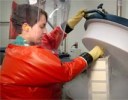
HHS Seeks Comments on Bioterror Select Agents List
The biennial review required by the Public Health Security and Bioterrorism Preparedness and Response Act of 2002 is under way. Comments about biological agents or toxins that should be added or removed are due by Aug. 20.
The U.S. Department of Health and Human Services published a notice Wednesday seeking comments by Aug. 20 about its current list of select agents and toxins. The Public Health Security and Bioterrorism Preparedness and Response Act of 2002 required creation of the list and a biennial review of it thereafter; the list consists of toxins and agents that could pose a severe threat to public health and safety. The HHS secretary is to consider their effect on human health upon exposure; how contagious they are; how they are transferred to humans; the availability and effectiveness of drugs and immunizations to treat and prevent resulting illnesses; their potential to be used as a biological weapon; and the needs of children and other vulnerable populations.
CDC's Division of Select Agents and Toxins has begun the biennial review process, which will include consultation with the Intragovernmental Select Agents and Toxins Technical Advisory Committee, which includes employees from USDA, DHS, DoD, FDA, and the National Institutes of Health.
The current list includes Ebola virus, anthrax, ricin, smallpox virus, Shiga toxin, Lassa fever virus, and Marburg virus. It can be found at http://www.selectagents.gov/Select%20Agents%20and%20Toxins%20List.html.
Beyond asking whether any biological agent or toxin should be added to or removed from the list, HHS wants comments on 1) whether it should tier the list based on the relative bioterrorism risk of each agent or toxin, or 2) "possibly further stratify the security requirements for agents in the highest tier based on type of use or other factors."
Comments may be e-mailed to [email protected] and should be marked "Comments on the changes to the list of select agents and toxins." They may be mailed to: Centers for Disease Control and Prevention, Division of Select Agents and Toxins, 1600 Clifton Road, MS A-46, Atlanta, GA 30333.